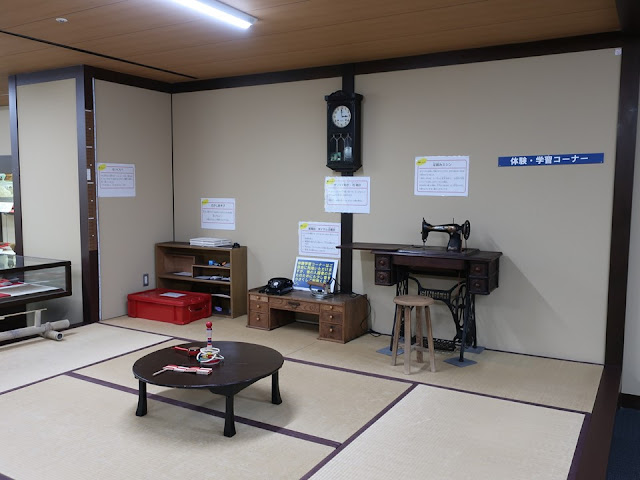This museum shows history and folklore of Minoh which is located in the north of Osaka. Many of them are shown by posters, not actual objects. About
the fun of Japanese, I am attracted by the lottery box which was used since
1748. I feel people’s passion to wish getting a lucky tag. Old photos also
attract me because they show me people’s vitality.
 |
| Entrance、資料館入口 |
 |
The exhibition area is as large as three
class rooms.
資料館内は教室三つぐらいだ
|
大阪北部・箕面市の歴史と民俗を展示している。実物よりも写真などのポスター展示が多い。人の楽しみとしては、1748年から使われていたという富くじの箱(実物)に人々の熱い願いを感じた。そして、意外と面白かったのは資料館の外に展示していた昔の写真。こちらは、人のパワーを感じさせる。
 |
Shine excavated porcelains in the ancient time.
古代の出土品を紹介するコーナー。磁気の光沢が美しい。
|
 |
This Buddhist scripture is the most
precious exhibit in this museum. This was left at Minoh, when monks carried
scriptures from Chusonji (northern Japan) to Kouyasan. Gold and silver
characters are excellent. The exhibition area is dim and photography is
prohibited, so this is a photo of its brochure.
本館の最も貴重な展示品・中尊寺経(リーフレットの写真)。照明を下げ、撮影禁止になっている。平泉・中尊寺から高野山に奉納に行く途中、箕面に残されたそうだ。金色と銀色で書かれたお経で美しい。
|
The lottery in Ryouannji temple is recorded on the document in the late 16th century. It is said the first lottery in Japan. People, who visited the temple from the New Year’s Day to the 7th of January, wrote their name on tags and dropped them in the lottery box. On the 7th, the monk tilted at tags in the box. Those were lucky tags and given to owners. There was no money prize, so it was not prohibited under the law in the Edo period. This event resumes and is held in October now.
 |
| Lottery box、富箱 |
龍安寺の「箕面富」は、天正年間(16世紀後半)の記録があり、最初の富くじと言われている。元旦から七日までに参詣した人々が自分の名前を書いた木札を富箱に入れ、七日に僧侶が突く。突かれた木札は富札として授けられる。金銭を賭けなかったので江戸時代の禁止令を免れ続けられた。明治時代に途絶えたが、現在は復活して10月に行われている。
 |
The model of the first café in Japan, which was opened in Minoh in
1911.
カフェーパウリスタ」の模型。1911年(明治44年)に最初のカフェーが箕面にできた。ちなみに、ミスタードーナツの一号店も箕面だそうです。 |
 |
We can get into this room of the early 20th century and
play.
昭和初期の部屋で遊べる体験コーナー
|
Photo exhibition outside of the museum 資料館外の写真展示
 |
This notified the opening of a new line
which linked Minoh and Osaka in 1910. This is also sexy, it’s strange.
大阪から箕面への電車開通。明治ですが、大正ロマンっぽい雰囲気です。 |
 |
This is an inn (ryokan) at the late 19th
century. Minoh is a popular tourist attraction in the north of Osaka.
明治期の旅館。箕面は大阪の北の行楽地として人気です。 |
 |
Performance in a village in the end of the 19th
century; it was a big fun for farmers after the farming season.
村芝居は、収穫後の一番の楽しみだった。 |
 |
People in Minoh in the early 20th
century.
箕面で暮らした普通の人々(昭和初期)
|
 |
Square in front of Minoh station. This
museum is on the left side of the building.
駅前ロータリーと資料館がある建物 |
 |
Souvenir shop which sells the Tempura
(fritter) of autumn leaves “Momiji-no-tempura”. It is bit sweet and crunchy.
紅葉の天ぷらのお土産店。紅葉の葉っぱを漬けた後、天ぷらにしている。少し甘くてサクサクだ。
|
 |
Hankyu train which has a distinct color and
Minoh station, plus Minoh mountains.
箕面駅。アズキ色の阪急電車と箕面の山です。 |
Five funs(楽fun)were found. Visited in October, 2018
Official website: https://www.city.minoh.lg.jp/kyoudo/home.html (in Japanese)
accessed in February, 2020
Previous post (Museum in the neighboring city):
Next post (Museum in the neighboring city):





Comments
Post a Comment